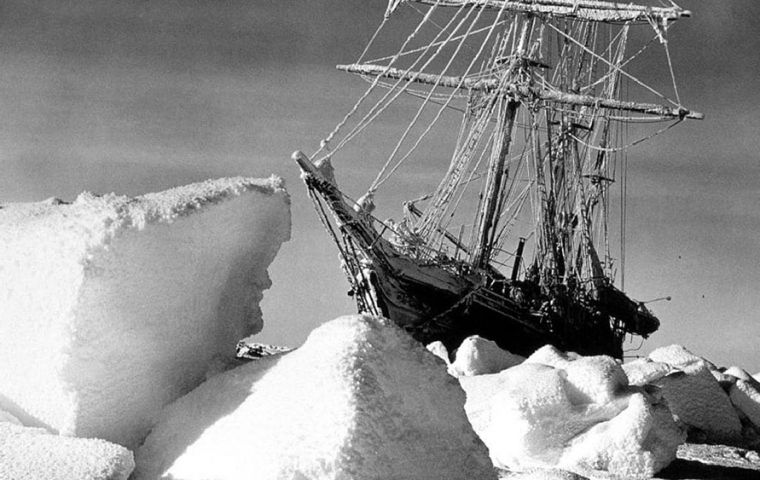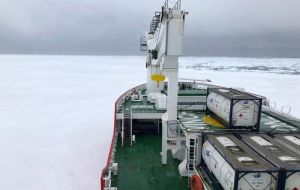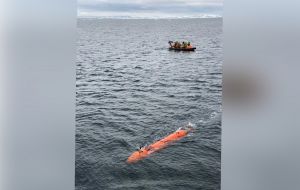MercoPress. South Atlantic News Agency
Falklander leads Shackleton's “Endurance” search team in Weddell Sea
 The Endurance encased in ice. In the end she was crushed and her stern rose twenty feet into the air, paused momentarily and then in one gulp was gone.
The Endurance encased in ice. In the end she was crushed and her stern rose twenty feet into the air, paused momentarily and then in one gulp was gone.  The bow of the pushing S. A. Agulhas II up against the ice shelf
The bow of the pushing S. A. Agulhas II up against the ice shelf  AUV about to go off under the ice. It is fitted with a special upward-looking sonar to study the underside of the ice shelf (Pic M. Bound)
AUV about to go off under the ice. It is fitted with a special upward-looking sonar to study the underside of the ice shelf (Pic M. Bound)Following on from Penguin News’ interview last week with Islander Mensun Bound, who was involved in the search for the Argentine submarine Ara San Juan, Mr Bound spoke of his current project, the search for Shackleton’s ship Endurance.
In August, 1914, as the world erupted into what would become the most destructive war in human history, they set off on an expedition which would become the stuff of legend.
Their goal was to cross Antarctica on foot from the Weddell Sea to the Ross Sea by way of the Pole. It was, in Shackleton’s words, “the last great journey left to man.” But they never even got started; in fact they never even set foot upon the great white continent.
In January 1915, while carving their way through the pack, their ship, the legendary Endurance, became icebound. In the end she was crushed and on November 21 they all watched in silence as her stern rose twenty feet into the air, paused momentarily and then in one gulp was gone. All that was left was a small dark opening in the ice, but within seconds the pack had closed leaving nothing to mark where she had been.
They were 28 little dots marooned on the ice at the heart of the most hostile sea on the planet. They were utterly alone, the nearest civilization was many hundreds of miles away. Their last contact with the outside world had been over 11 months before, they did not have a radio and nobody knew where they were.
Their prospect of rescue was nil. The Endurance sank at 5 pm.
In his tent that evening Shackleton tried to describe what had happened. “She went today,” he began. He struggled on another 43 words and then gave up. “I cannot write about it,” he concluded.
They expected to die – slowly and horribly - but what followed was the greatest Antarctic adventure there has ever been and, arguably, the greatest story of human survival in recorded history. The most remarkable thing about the Shackleton saga is that they all lived to tell the story.
If Shackleton’s objective was to cross Antarctica then Mensun Bound’s and his crew is to locate his ship.
On January 1 they gathered, mission-ready, upon the freezing white banks of the Weddell Sea. On January 4, a little later than planned, they set sail on the South African icebreaker Agulhas II for the Larsen C ice shelf.
Mr. Bound said: “The greater part of our expedition will be scientific, but towards the end we will plunge the abyss in an attempt to find the Endurance. As a maritime archaeologist I can say with little fear of contradiction that this will be the greatest wreck-search there has ever been.
“Conditions and equipment allowing, and at a cost of millions, we will journey into what Shackleton himself called ‘the worst corner of the worst sea on earth’, and then, using the most advanced deep-ocean search-and-survey technology available, go under the pack to 3,000 meters to hunt for what has been called the most iconic ship of all time.”
But why search for the vessel at all?
Mr. Bound’s answer is: “We are seeking to find the Endurance so that she might be protected and preserved into the future, when conservation science will have advanced sufficiently for a responsible body to consider whether it would be advisable to raise her remains for preservation and public display.”
He worries: “Think what happened to the Titanic, which sank just three years before the Endurance (and which also went down lacerated by ice while on her maiden voyage). The moment she was found, the site became a free-for-all, a help-yourself and smash-and-grab for anybody with a deep-water submersible.”
Currently the aim is not to touch anything if the vessel is found and by the terms of their permit issued by the Polar Regions Department of the FCO they are not allowed to touch or raise anything explained Mr. Bound. (Penguin News).




Top Comments
Disclaimer & comment rulesCommenting for this story is now closed.
If you have a Facebook account, become a fan and comment on our Facebook Page!